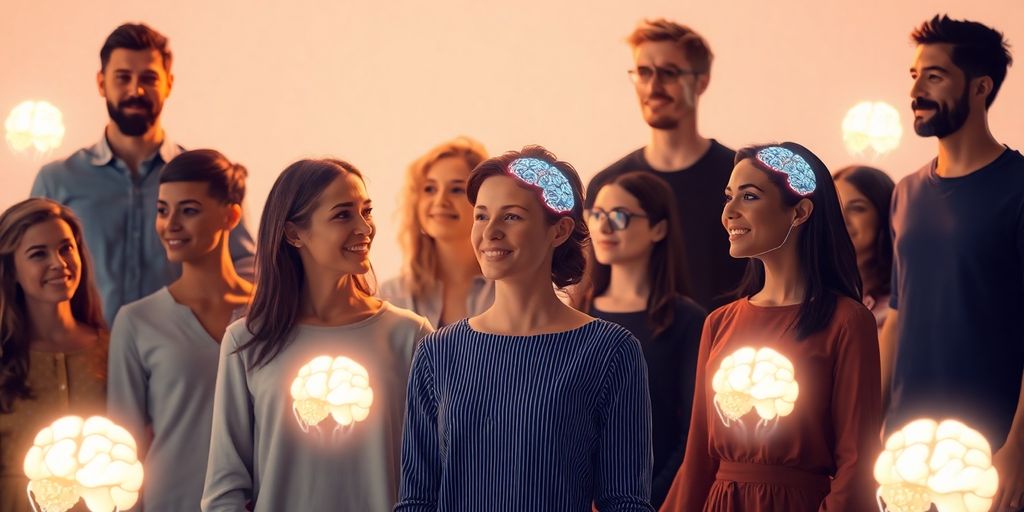As AI Transforms Business, Human Skills Become the Ultimate Competitive Advantage
Discover how human skills become the ultimate competitive advantage as Business AI transforms the business landscape.
So, everyone's talking about Business AI these days, right? It's changing everything about how companies work. You might think machines are just going to take over, but actually, it looks like human skills are becoming super important. Things like thinking smart, understanding people, and coming up with new ideas are what will really make a difference. This article talks about how Business AI is shaking things up and why being human is still a big deal for success.
Key Takeaways
Business AI is changing how companies grow, moving past old ways that relied only on people.
The idea that you always need a 'human touch' in sales isn't always true anymore, especially for quick, simple deals.
Companies need to help their people learn new skills to work well with Business AI.
Leaders have to be forward-thinking and create a workplace that can handle quick changes with Business AI.
When people and Business AI work together, it creates a strong advantage for businesses.
The Shifting Landscape of Business AI

It feels like just yesterday we were all trying to figure out what 'the cloud' even was, and now we're staring down the barrel of AI transforming everything. The speed at which AI in business is evolving is honestly kind of mind-blowing. What worked last year might be totally obsolete now. It's not just about adopting new tech; it's about fundamentally rethinking how we approach growth and strategy.
The Limits of Human-First Growth
For a long time, the mantra was that growth was always 'human-first.' But what if that's not always the most efficient or effective path to growth? Perhaps it's time to redefine what 'human-first' truly means in an era where AI can handle tasks with unprecedented efficiency and scale.
Beyond the Human Touch in Business AI
The Fallacy of the Human Touch
We often hear about the importance of the 'human touch' in business, especially when discussing customer service or sales. But let's be real, sometimes that 'human touch' is just code for inefficiency, bias, and inconsistency. AI offers the chance to move beyond these limitations, creating systems that are more reliable and scalable. Think about it: a chatbot that's always polite, always available, and never has a bad day. That's a pretty compelling alternative to relying solely on human agents. It's not about eliminating humans entirely, but about strategically deploying them where they can add the most value, like handling complex cases or providing emotional support.
Building the Post-Human Go-To-Market Stack
So, what does a post-human go-to-market stack actually look like? It's about integrating AI at every stage of the customer journey. Here's a few things to consider:
AI-powered lead generation: Use machine learning to identify and qualify leads more effectively than traditional methods.
Automated customer service: Implement chatbots and AI assistants to handle routine inquiries and provide instant support.
Predictive analytics for sales: Use AI to forecast sales trends and identify opportunities for growth.
The goal isn't to replace humans, but to augment their abilities and free them up to focus on higher-level tasks. This means investing in the right tools, training, and processes to ensure that humans and AI can work together effectively.
Autonomous Revenue Units
Imagine a world where entire business units operate autonomously, driven by AI. Sounds like science fiction? Maybe not for long. Autonomous Revenue Units (ARUs) are self-organizing systems that can generate revenue with minimal human intervention. These units use AI to handle everything from marketing and sales to customer service and product development. The Anthropic Economic Index shows that AI is already shifting how people approach tasks in their day-to-day work.
Here's a simplified view of how ARUs might impact revenue generation:
ARUs aren't about replacing human workers; they're about creating new opportunities for growth and innovation. By automating routine tasks and freeing up humans to focus on higher-level activities, businesses can achieve unprecedented levels of efficiency and profitability. The key is to design these systems in a way that optimizes human potential and ensures that AI is used ethically and responsibly.
Cultivating Essential Human Skills for Business AI

It's easy to get caught up in the tech, but let's be real: AI isn't going to replace humans entirely. Instead, it's changing what skills are most important for us to have. We need to focus on the things AI can't easily replicate.
Strategic Thinking and Problem Solving
AI can crunch numbers and spit out data all day, but it can't really think strategically. That's where humans come in. We need to be able to look at the big picture, understand complex problems, and come up with creative solutions that AI just wouldn't see. It's about seeing beyond the data and understanding the context.
Emotional Intelligence and Empathy
This is a big one. AI can mimic human interaction, but it can't actually feel anything. Understanding emotions, showing empathy, and building real relationships are things that will always be uniquely human. These skills are super important for leadership, teamwork, and even customer service. It's about connecting with people on a deeper level. Cultivating human skills is crucial to ensure humans remain the primary decision-makers, utilizing AI as a supportive tool.
Creativity and Innovation
AI can generate content and automate tasks, but it's not really creative. True innovation comes from human imagination, curiosity, and the ability to think outside the box. We need to encourage people to experiment, take risks, and come up with new ideas. It's about pushing the boundaries of what's possible.
In the age of AI, it's easy to think that technical skills are all that matter. But the truth is, human skills are more important than ever. We need to invest in training and development programs that help people build these skills. It's not just about keeping up with the machines; it's about staying ahead.
Navigating the Future of Work with Business AI
Upskilling and Reskilling Initiatives
Okay, so AI is changing stuff, like, a lot. One of the biggest things companies are thinking about is how to get their people ready for it. It's not just about learning new software; it's about changing how people think about their jobs.
Companies are starting to offer training programs to help employees learn new skills.
Some are partnering with colleges and universities to create custom courses.
A big part of this is teaching people how to work with AI, not against it.
Collaboration Between Humans and Business AI
The future isn't about robots replacing everyone; it's about humans and AI working together. Think of AI as a super-smart assistant that can handle the boring stuff, freeing up humans to do the creative, strategic work. It's a bit like having a really, really good intern, but one that never sleeps and doesn't need coffee.
It's important to figure out what tasks are best suited for AI and what tasks still need a human touch. It's not always obvious, and it'll probably take some experimenting to get it right.
Ethical Considerations in Business AI Deployment
Let's be real, AI isn't perfect. It can be biased, it can make mistakes, and it can be used in ways that aren't exactly ethical. Companies need to think about this stuff before they roll out AI, not after.
Data privacy is a huge deal. What data are you collecting, and how are you using it?
Bias in algorithms can lead to unfair outcomes. How do you make sure your AI is fair?
Transparency is key. People need to understand how AI is being used and why.
Here's a quick look at some potential ethical issues:
Leadership in the Age of Business AI
It's a whole new ballgame for leaders now that business AI is becoming so widespread. It's not just about understanding the tech; it's about how you guide your team through this change. Think of it as less about being the smartest person in the room and more about being the best conductor of the orchestra.
Visionary Leadership for Business AI Integration
Leaders need to paint a clear picture of how AI fits into the company's future. It's not enough to just say, "We're using AI now!" You have to explain why, and how it helps everyone reach their goals. This means communicating the benefits, addressing concerns, and showing how AI can make jobs better, not just replace them. It's about creating a shared understanding and excitement around the possibilities. For example, leaders should be willing to learn as their most crucial trait.
Fostering a Culture of Adaptability
Things are changing fast, and leaders need to build teams that can keep up. This means:
Encouraging continuous learning and experimentation.
Creating a safe space for people to try new things and even fail.
Being open to feedback and adjusting plans as needed.
A culture of adaptability isn't just about reacting to change; it's about anticipating it and being ready to embrace new ways of working. It's about building a team that sees change as an opportunity, not a threat.
Measuring Success Beyond Traditional Metrics
We can't just look at the old numbers anymore. With AI in the mix, we need to think about new ways to measure success. This might include:
Employee satisfaction and engagement.
The speed and quality of decision-making.
The level of innovation within the company.
It's about finding metrics that truly reflect the impact of AI on the business and the people who make it run.
The Competitive Edge of Human-AI Synergy
It's not about humans versus AI. It's about humans with AI. The real magic happens when we figure out how to make these two work together. The competitive advantage in the future won't just be about having the best AI, but about how well you can blend human skills with AI capabilities.
Optimizing Business AI for Human Potential
Think of AI as a tool, not a replacement. We need to focus on how AI can make people better at their jobs. For example, AI can handle repetitive tasks, freeing up humans to focus on more strategic and creative work. It's about finding the right balance. It's about human strengths and machine intelligence.
Designing Human-Centric Business AI Systems
AI systems should be designed with the user in mind. This means making them easy to use, understand, and trust. If people don't trust the AI, they won't use it. And if they can't use it effectively, it's not helping anyone. It's also important to consider the ethical implications of AI and make sure that it's used responsibly. We need to think of AI as "normal".
The Uniqueness of Human Contribution
Even with all the advances in AI, there are some things that humans will always do better. Things like complex problem-solving, empathy, and creativity. These are the skills that will set businesses apart in the age of AI. It's not enough to just have AI; you need people who can use it to its full potential. It's about adaptive production and reinventing the rules of competition.
The key is to understand that AI is a tool, and like any tool, it's only as good as the person using it. We need to invest in training and development to make sure that people have the skills they need to work effectively with AI. This means teaching people how to use AI tools, but also how to think critically and creatively about how AI can be used to solve business problems.
Here's a quick look at how human skills and AI can work together:
Data Analysis: AI can process huge amounts of data, but humans are needed to interpret the results and make decisions.
Customer Service: AI chatbots can handle basic inquiries, but humans are needed to handle complex or emotional issues.
Product Development: AI can generate ideas and prototypes, but humans are needed to refine them and make them marketable.
The Human Element: Still the Main Thing
So, yeah, AI is changing a lot of things in business, and it's happening fast. We're seeing machines do stuff that used to be just for people. But here's the deal: even with all this tech, the things that make us human — like being able to think in new ways, work with others, and just get what people need — those are still super important. They're not going away. In fact, they're probably going to be even more valuable as AI takes over the routine stuff. So, while we figure out how to use AI, let's also remember to keep building up those human skills. That's what will really make a difference in the long run.
Head over to our Shopfiy store for in-depth ebooks to help you master AI for business and entrepreneurship.
Frequently Asked Questions
How is AI changing the business world?
AI is changing how businesses work by taking over some tasks that people used to do. This means people need to focus on skills like thinking creatively, solving hard problems, and understanding others, because these are things AI can't do as well.
What's wrong with the 'human touch' in business now?
The 'human touch' used to be super important, especially in sales. But now, for many simple tasks, people want things fast and easy. AI can give quick answers and consistent service, which sometimes works better than a human. So, the human touch is still needed for big, complicated deals, but less for everyday stuff.
What is the 'GTM Singularity'?
We're seeing a shift where AI systems will soon be able to do many business tasks better and faster than people. This means AI won't just help people; it will start to do more on its own, like handle sales and customer service without needing a human to step in.
How are companies building new ways to sell with AI?
Businesses are breaking down their sales steps into smaller parts that AI can handle. They're also using AI 'sellers' that can talk to customers through email or chat. Plus, they're teaching the AI with lots of customer info so it gets smarter.
What can AI do that humans can't in business?
AI can do things like answer questions quickly, manage customer follow-ups, and even create sales quotes. It can also learn from lots of data and work nonstop, which humans can't do.
What is the F.L.I.P. framework?
The F.L.I.P. framework helps companies figure out which parts of their business can be done by AI and which still need people. It looks at how complex a task is, how fast it needs to be done, how risky it is if something goes wrong, and if the process is already well-organized.








